Hydrologic Controls and Water Vulnerabilities in the Naryn River Basin, Kyrgyzstan: A Socio-Hydro Case Study of Water Stressors in Central Asia
Abstract
:1. Introduction
2. Materials and Methods
2.1. Quantifying the Hydrologic Setting
2.2. Synoptic Sample Design
2.3. Water Sample Collection and Analysis
2.4. Mixing Models and Source Water Separations
2.5. Socio-Hydro Surveys
3. Results
3.1. Hydrologic Setting
3.2. Hydro Chemistry Elevation Gradient
3.3. EMMA Diagnostics and Mixing Model Results
3.3.1. Upper Naryn
3.3.2. Lower Naryn
3.3.3. Mixing Model Validation
3.4. Socio-Hydro Results
- Gaps in knowledge. Farmers accustomed to single task jobs associated with large scale farming practices lacked knowledge about crop rotation, irrigation techniques suitable for the climate and soils of the Naryn basin, and the complete cycle of agricultural production needed for productive small-plot farming.
- A lack of agricultural, economic, educational and hydrologic infrastructure needed to service small-plot farmers. Farmers were ill-equipped without financing options, reliable irrigation and water distribution, and appropriate machinery. As a result, yields declined and irrigation systems deteriorated leading to greater inefficiencies.
- Complete absence of new irrigation technologies.
- Inadequate government support for struggling farmers due to understaffed water management offices in the region. A shortage of qualified specialists was largely attributed to low compensation.
4. Discussion
4.1. Use of EMMA over Regional Scales
4.2. Hydrologic Controls on River Flow
4.3. Social Implications
5. Conclusions
Supplementary Materials
Acknowledgments
Author Contributions
Conflicts of Interest
References
- Barnett, T.P.; Adam, J.C.; Lettenmaier, D.P. Potential impacts of a warming climate on water availability in snow-dominated regions. Nature 2005, 438, 303–309. [Google Scholar] [CrossRef] [PubMed]
- Hennessy, K.B.; Fitzharris, B.; Bates, B.C.; Harvey, N.; Howden, M.; Hughes, L.; Salinger, J.; Warrick, R. Contribution of Working Group II to the Fourth Assessment Report of the Intergovernmental Panel on Climate Change. In Climate Change 2007: Impacts, Adaptation and Vulnerability; Parry, M., Canziani, O., Palutikof, J., van der Linden, P., Hanson, C., Eds.; Cambridge University Press: Cambridge, UK, 2007. [Google Scholar]
- Immerzeel, W.W.; van Beek, L.P.H.; Bierkens, M.F.P. Climate Change Will Affect the Asian Water Towers. Science 2010, 328, 1382. [Google Scholar] [CrossRef] [PubMed]
- Wilson, A.M.; Gladfelter, S.; Williams, M.W.; Shahi, S.; Baral, P.; Armstrong, R.; Racoviteanu, A. High Asia: The International Dynamics of Climate Change and Water Security. J. Asian Stud. 2017. [Google Scholar] [CrossRef]
- EurasiaNet. Kyrgyzstan: Russia Pushing to Get Dam Money Back. Available online: http://www.eurasianet.org/node/80181 (accessed on 17 August 2016).
- Gleick, P.H.; Heberger, M. Water Conflict Chronology. In The World’s Water; Gleick, P.H., Ed.; Island Press: Washington, DC, USA, 2014; pp. 173–219. [Google Scholar]
- The Economist. Mi CASA no es tu CASA. Available online: http://www.economist.com/news/asia/21608806-plan-export-electricity-looks-cursed-mi-casa-no-es-tu-casa (accessed on 26 June 2014).
- The Economist. Gold in the Hills: Attitudes towards Foreign Investors Hold a Troubled Country Back. Available online: http://www.economist.com/news/asia/21573615-attitudes-towards-foreign-investors-hold-troubled-country-back-gold-hills (accessed on 16 May 2013).
- Carey, M.; Molden, O.C.; Rasmussen, M.B.; Jackson, M.; Nolin, A.W.; Mark, B.G. Impacts of Glacier Recession and Declining Meltwater on Mountain Societies. Ann. Am. Assoc. Geogr. 2017, 107, 350–359. [Google Scholar] [CrossRef]
- Painter, T.H.; Rittger, K.; McKenzie, C.; Slaughter, P.; Davis, R.E.; Dozier, J. Retrieval of subpixel snow covered area, grain size, and albedo from MODIS. Remote Sens. Environ. 2009, 113, 868–879. [Google Scholar] [CrossRef]
- Rittger, K.; Painter, T.H.; Dozier, J. Assessment of methods for mapping snow cover from MODIS. Adv. Water Resour. 2013, 51, 367–380. [Google Scholar] [CrossRef]
- Pfeffer, W.T.; Arendt, A.A.; Bliss, A.; Bolch, T.; Cogley, J.G.; Gardner, A.S.; Sharp, M.J. The Randolph Glacier Inventory: A globally complete inventory of glaciers. J. Glaciol. 2014, 60, 537–552. [Google Scholar] [CrossRef]
- Raup, B.; Racoviteanu, A.; Khalsa, S.J.S.; Helm, C.; Armstrong, R.; Arnaud, Y. The GLIMS geospatial glacier database: A new tool for studying glacier change. Glob. Planet. Chang. 2007, 56, 101–110. [Google Scholar] [CrossRef]
- Christophersen, N.; Hooper, R.P. Multivariate analysis of stream water chemical data: The use of principal components analysis for the end-member mixing problem. Water Resour. Res. 1992, 28, 99–107. [Google Scholar] [CrossRef]
- Liu, F.J.; Williams, M.W.; Caine, N. Source Waters and Flow Paths in Alpine Catchment, Colorado Front Range, United States. Water Resour. Res. 2004, 40. [Google Scholar] [CrossRef]
- Wilson, A.; Williams, M.W.; Kayastha, R.B.; Racoviteanu, A. Use of a hydrologic mixing model to examine the roles of meltwater, precipitation and groundwater in the Langtang River basin, Nepal. Ann. Glaciol. 2016. [Google Scholar] [CrossRef]
- Cowie, R.M.; Knowles, J.F.; Dailey, K.R.; Williams, M.W.; Mills, T.J.; Molotch, N.P. Sources of streamflow along a headwater catchment elevational gradient. J. Hydrol. 2017. [Google Scholar] [CrossRef]
- Hooper, R.P.; Christophersen, N.; Peters, N.E. Modelling Streamwater Chemistry as a Mixture of Soilwater End-Members—An Application to the Panola Mountain Catchment, Georgia, USA. J. Hydrol. 1990, 116, 321–343. [Google Scholar] [CrossRef]
- Hooper, R.P. Diagnostic Tools for Mixing Models of Stream Water Chemistry. Water Resour. Res. 2003, 39. [Google Scholar] [CrossRef]
- Liu, F.; Parmenter, R.; Brooks, P.D.; Conklin, M.H.; Bales, R.C. Seasonal and interannual variation of streamflow pathways and biogeochemical implications in semi-arid, forested catchments in Valles Caldera, New Mexico. Ecohydrology 2008, 1, 239–252. [Google Scholar] [CrossRef]
- Liu, F.; Conklin, M.H.; Shaw, G.D. Insights into hydrologic and hydrochemical processes based on concentration-discharge and end-member mixing analyses in the mid-Merced River Basin, Sierra Nevada, California. Water Resour. Res. 2017, 53, 832–850. [Google Scholar] [CrossRef]
- Kundzewicz, Z.W.; Nohara, D.; Tong, J.; Oki, T.; Buda, S.; Takeuchi, K. Discharge of large Asian rivers—Observations and projections. Quat. Int. 2009, 208, 4–10. [Google Scholar] [CrossRef]
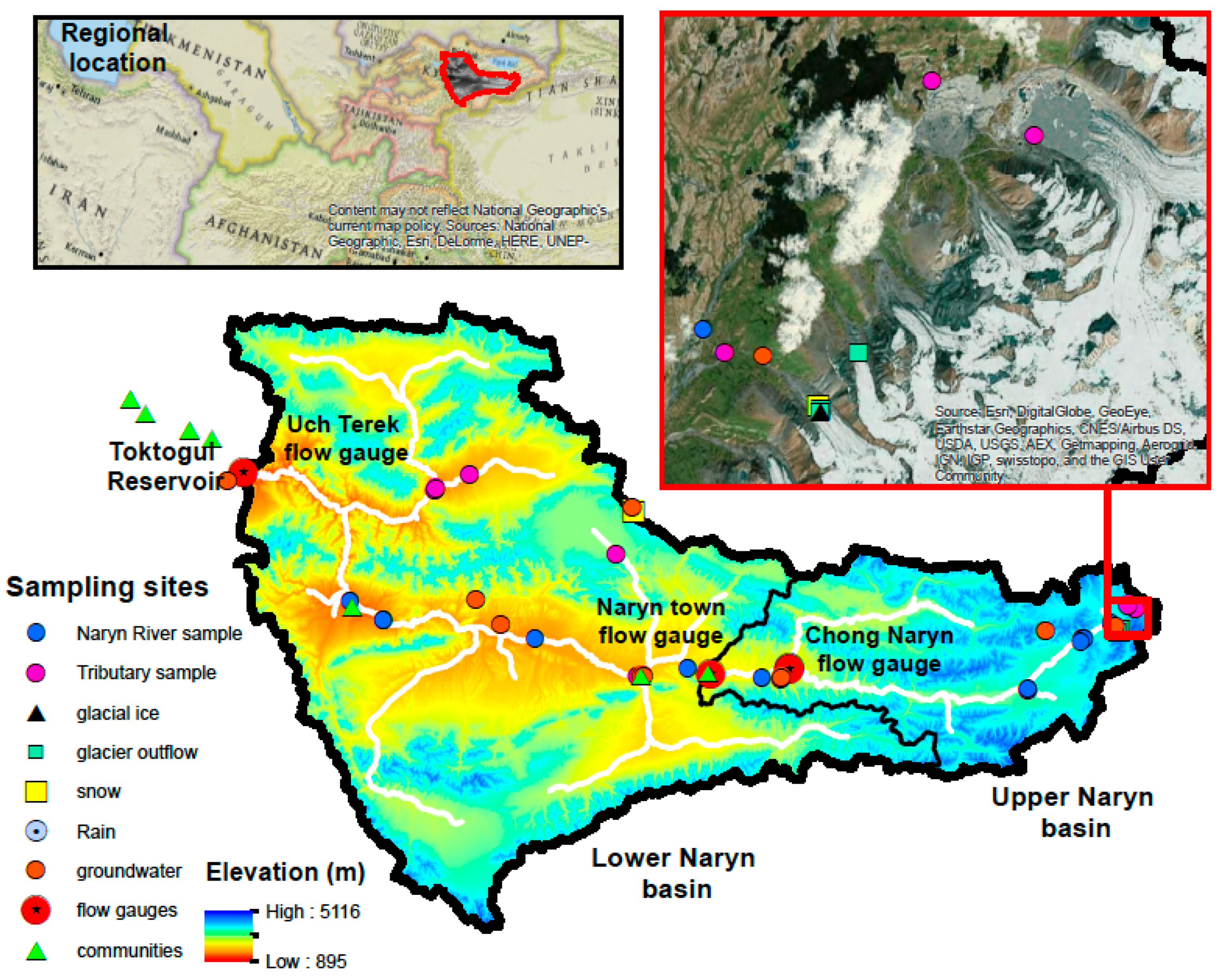
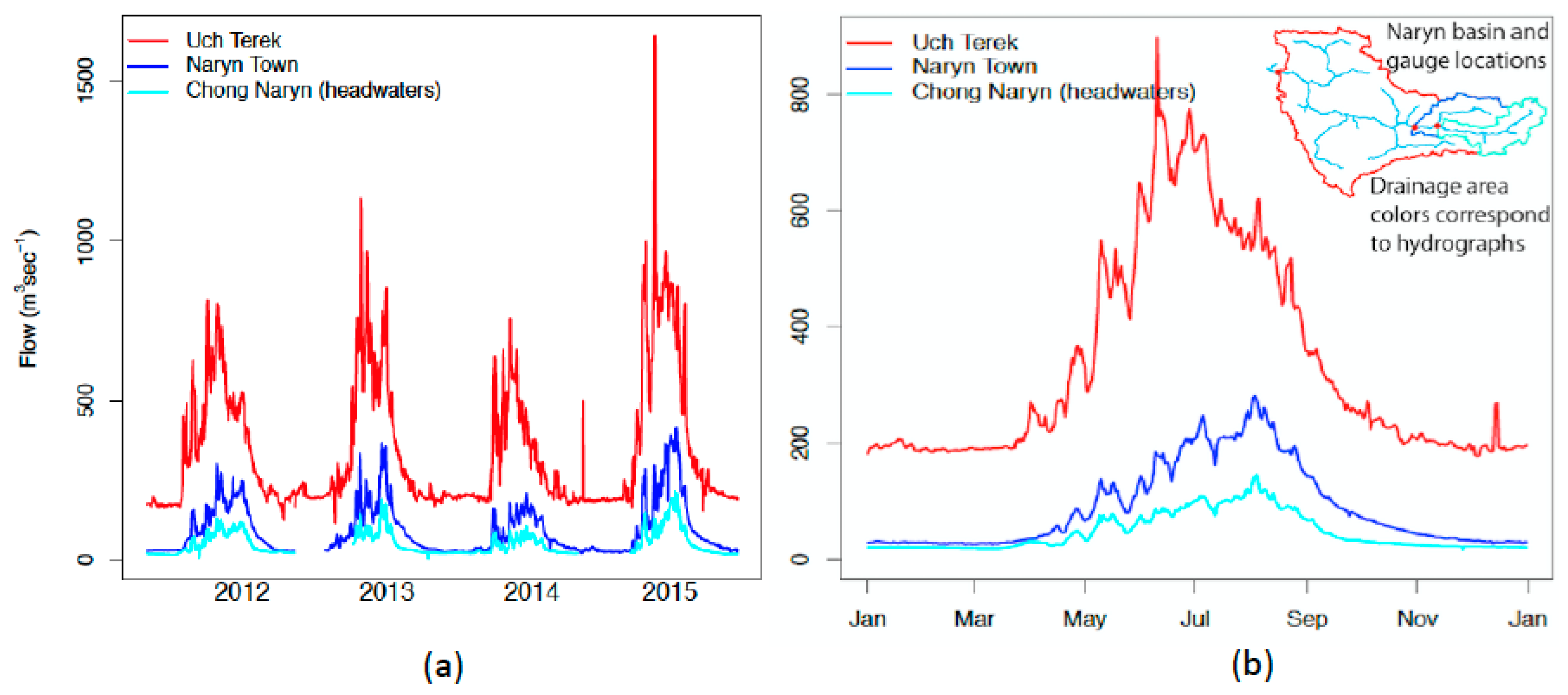
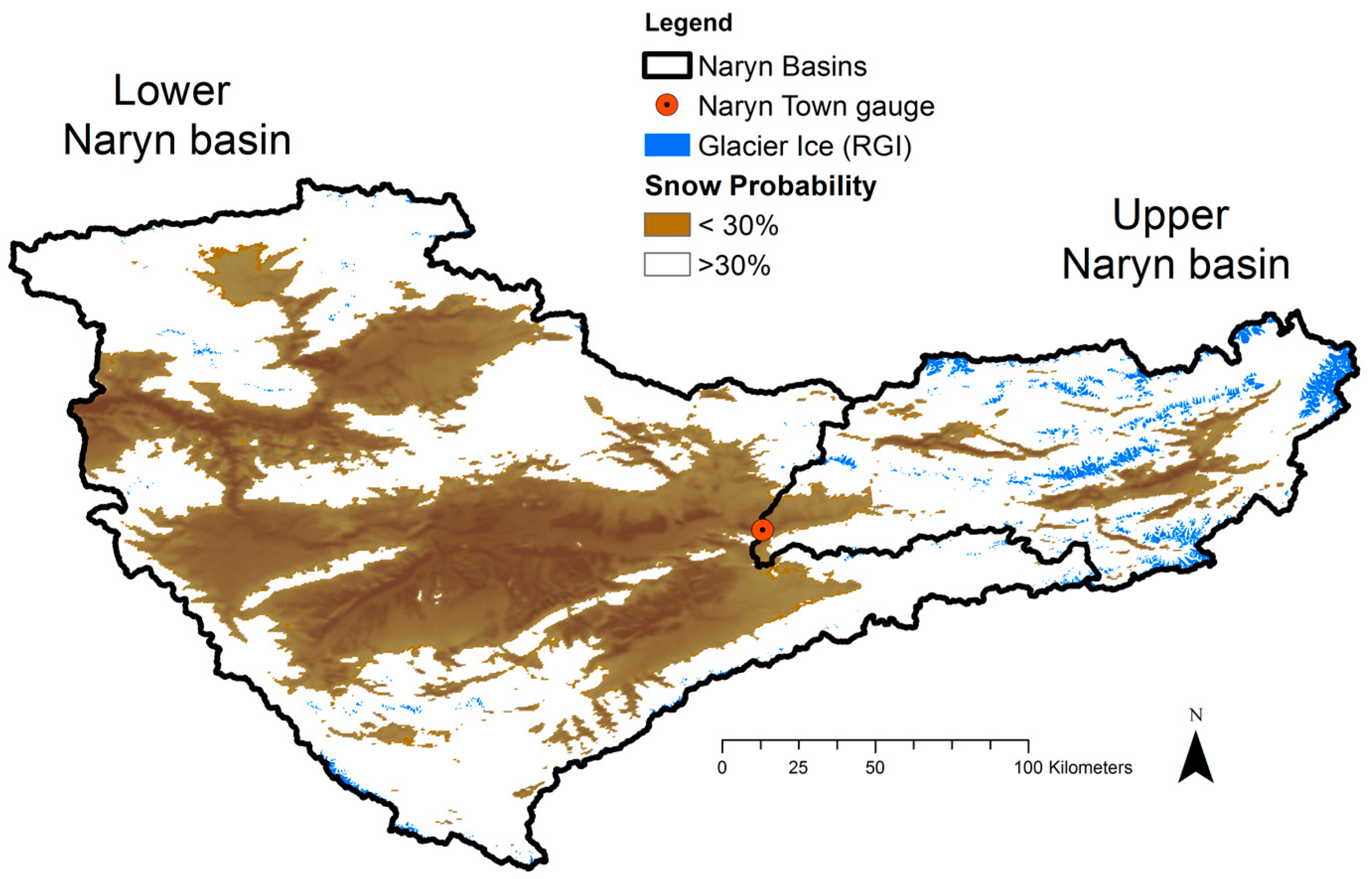
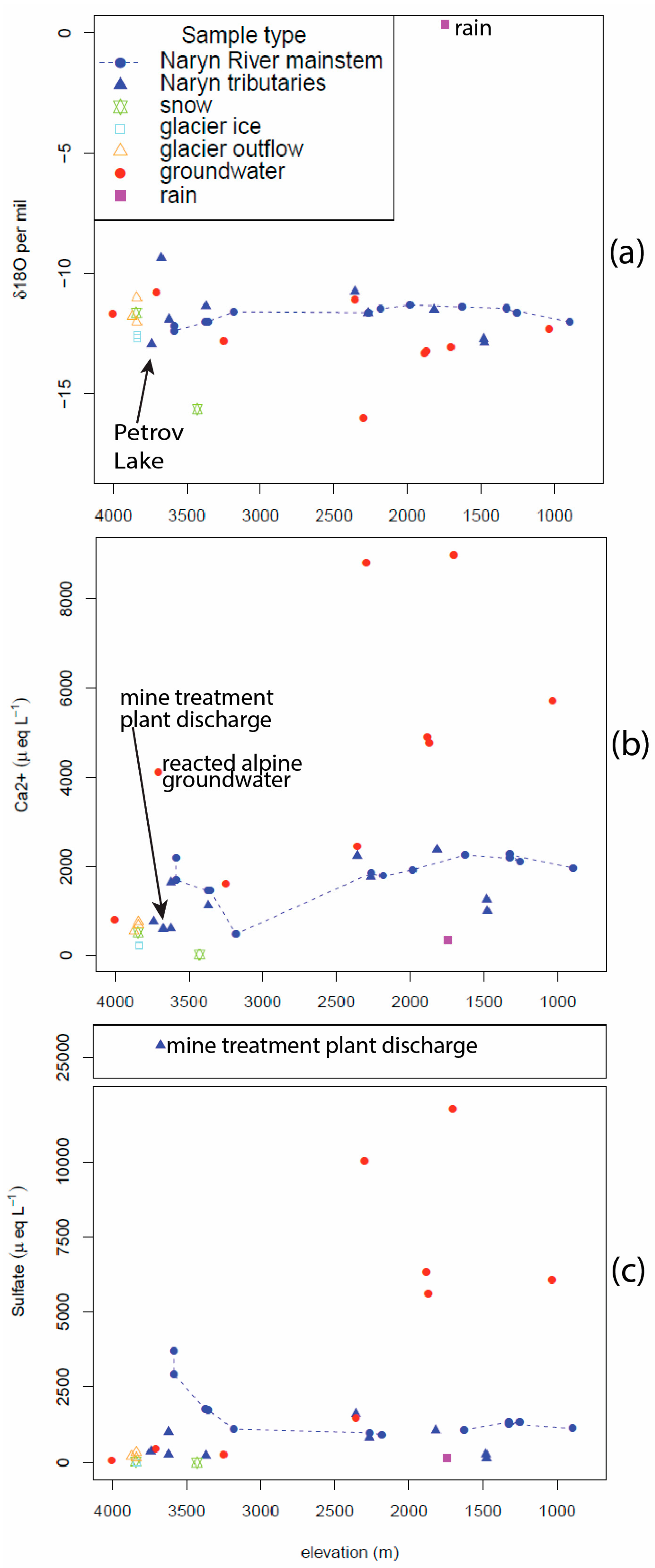

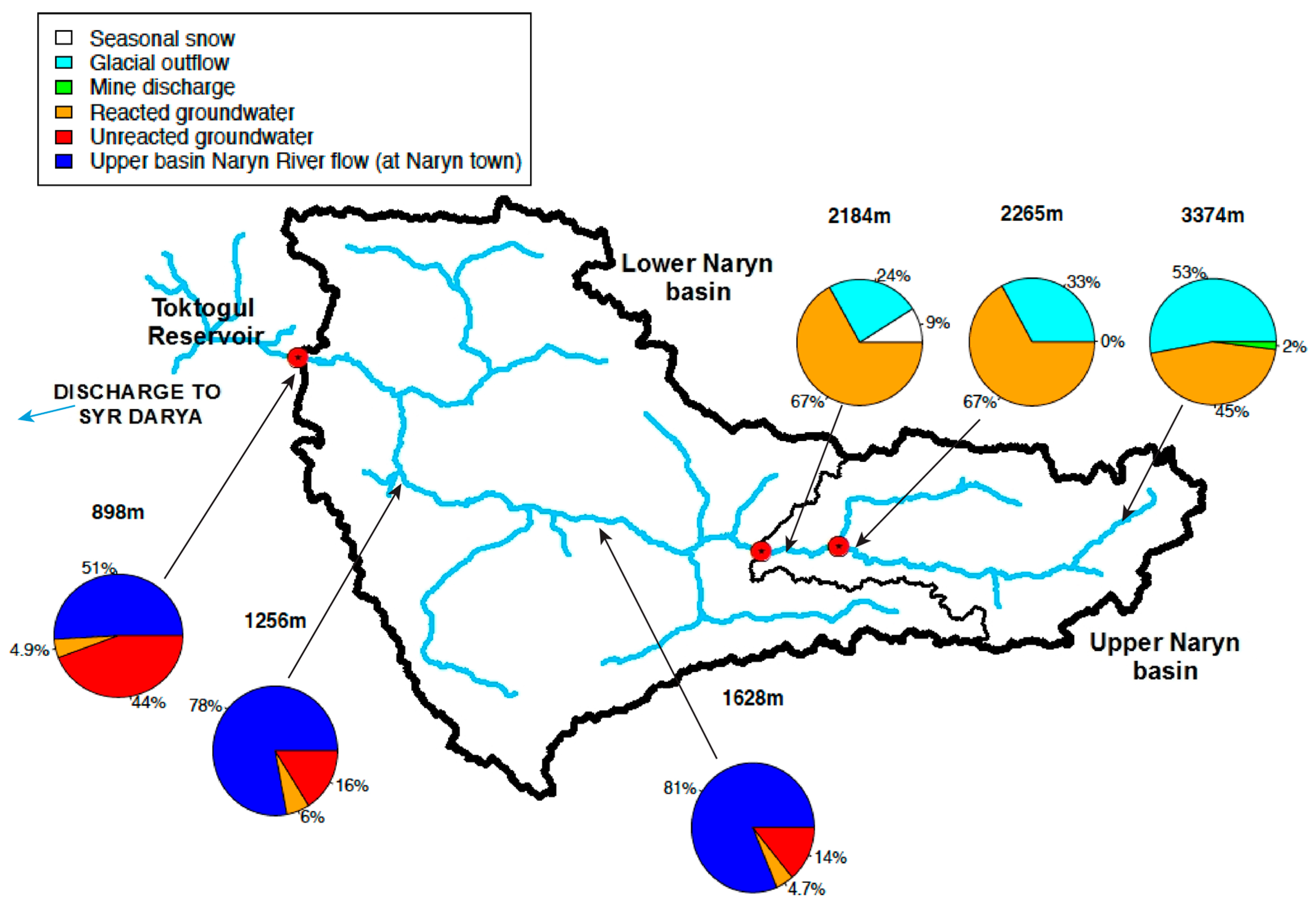
| Reach | Tracers Used | End Members | Sample Used to Characterize End Member | End Member Selection Rationale |
|---|---|---|---|---|
| UPSTREAM: From glacier snout to Naryn town | Ca2+, Na+, K+, SO42−, δ18O | Mine discharge | Mine discharge tributary | Clear explanatory power regarding chemical progression of upstream samples |
| Seasonal snow | Bordu snow | Well positioned to constrain samples in EMMA diagram, acceptable Euclidean distances but important for concentration reconstructions | ||
| Glacial outflow | Petrov Lake | Well positioned to constrain samples in EMMA diagram, Low Euclidean distances | ||
| Reacted upstream groundwater | Tash Prabat groundwater well | Well positioned to constrain samples in EMMA diagram, Low Euclidean distances | ||
| DOWNSTREAM: From Naryn town to Toktogul Reservoir | Ca2+, Mg2+, Na+, K+, Cl−, SO42−, δ18O | Upper Naryn River | Naryn River above Naryn town | Well positioned to constrain samples in EMMA diagram, Low Euclidean distances, an obvious source water to downstream flow |
| Reacted downstream groundwater | At Kiya well | Low Euclidean distances, EMMA diagram location encapsulates samples despite not being a “tight” fit. | ||
| Unreacted (lateral flow) groundwater | Kalmak spring | Well positioned to constrain samples in EMMA diagram, Low Euclidean distances |
| Analyte | Ca2+ | Mg2+ | Na+ | K+ | Cl− | NO3− | SO42− | δ18O | δD |
|---|---|---|---|---|---|---|---|---|---|
| Downstream Naryn basin model | 0.92 | 0.43 | 0.95 | 0.95 | 0.68 | 0.95 | 0.9 | 0.78 | 0.77 |
| Upstream Naryn basin model | 0.84 | 0.84 | 0.96 | 0.83 | 0.94 | 0.79 | 0.9 | 0.92 | 0.85 |
© 2017 by the authors. Licensee MDPI, Basel, Switzerland. This article is an open access article distributed under the terms and conditions of the Creative Commons Attribution (CC BY) license (http://creativecommons.org/licenses/by/4.0/).
Share and Cite
Hill, A.F.; Minbaeva, C.K.; Wilson, A.M.; Satylkanov, R. Hydrologic Controls and Water Vulnerabilities in the Naryn River Basin, Kyrgyzstan: A Socio-Hydro Case Study of Water Stressors in Central Asia. Water 2017, 9, 325. https://doi.org/10.3390/w9050325
Hill AF, Minbaeva CK, Wilson AM, Satylkanov R. Hydrologic Controls and Water Vulnerabilities in the Naryn River Basin, Kyrgyzstan: A Socio-Hydro Case Study of Water Stressors in Central Asia. Water. 2017; 9(5):325. https://doi.org/10.3390/w9050325
Chicago/Turabian StyleHill, Alice F., Cholpon K. Minbaeva, Alana M. Wilson, and Rysbek Satylkanov. 2017. "Hydrologic Controls and Water Vulnerabilities in the Naryn River Basin, Kyrgyzstan: A Socio-Hydro Case Study of Water Stressors in Central Asia" Water 9, no. 5: 325. https://doi.org/10.3390/w9050325





